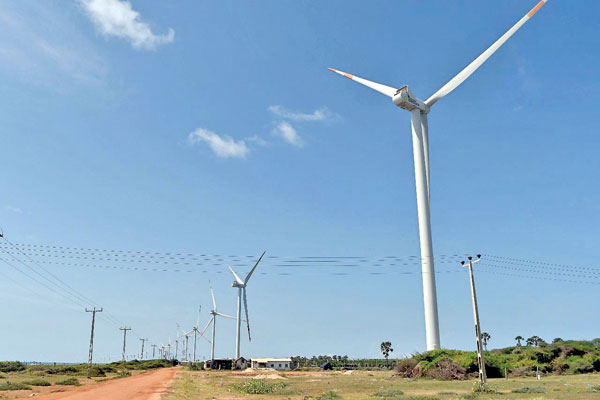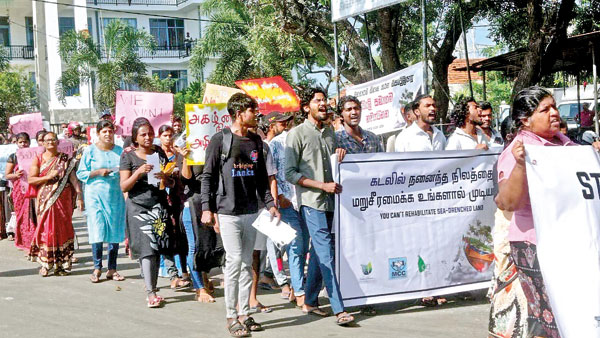News
Gone with the wind: Mannar fisherfolk fear of being blown away by turbine project
View(s):- Govt. and EIA give assurances of compensation and alternatives, but fisherfolk and residents say they face drowning
By S. Rubathesan from Mannar
Three years later, residents are up in arms once again against the proposed extension of the project, with dozens of more wind turbines on the flat lowland island and coastal areas being planned.
Sepamalai Arulnesan Rodwin, 55, from Thalvupadu, a coastal village where the first stage of the Ceylon Electricity Board (CEB)-commissioned 103.5 megawatt (MW) wind power plant was implemented years ago, now has to go more nautical miles to engage in fishing as there were no fish banks near the coastal waters.

The wind power farm in Thalvupadu
“Before the wind farm was set up, we could engage in fishing near the coastal stretch within two kilometres, but not anymore as they all disappeared due to sound and vibration. Nowadays, we have to go far, about 16–18 kilometres in the sea, but we cannot afford such trips after fuel price hikes,” said the father of two, who has been engaged in beach seine or coastal fishing for nearly three decades.
Even if they tried to go a further 24 kilometres in the Mannar Sea, they could possibly be arrested by the Indian Coast Guard for entering Indian territorial waters.
“Unlike other fishermen who engage in different seasonal fishing methods throughout the year, we have only this sea for our survival. These days, our total catch is around 45–60 kilos of fish per boat. Even that is not certain on some days,” Mr. Rodwin said while stressing that the cost of covering expenses to finance a single trip is higher than the fish catch.
At least 300 fisher families attached to the Thalvupadu Fishermen Cooperative Society, one of the 18 societies in the district, depend on fishing-related activities for daily survival. With the skyrocketing cost of living and the inability to engage in fishing any longer, many fishermen switched to other jobs such as daily labour, or masonry in recent months.

Protest against the proposed second phase of the wind power project in Mannar last week
“Earlier, many of our women engaged in making dried fish or assisted us in jettying, but now they are forced to do other jobs or work in the nearby canned fish factories or farms,” said another fisherman, S.K. Cruz.
In addition to the existing CEB-commissioned 103.5 MegaWatt (MW) ‘Thambapavani’ wind farm built with a USD 140 million Asian Development Bank (ADB) credit facility, the government is determined to go ahead with the proposed 250 MW second phase of the project, which is backed by India’s Adani Green Energy Sri Lanka Limited (AGESL) with an investment of about USD 420 million.
Unlike the first phase of the project, which saw the setting up of 30 turbines in a coastal area, the proposed second phase is found to be in the middle of the protected regions: the Adams Bridge National Park, the Vidataltivu Nature Reserve, and the Vankalai Sanctuary, a Ramsar site. The proposed wind farm consists of 52 turbines of 5.2 MW each and will be in place along with the existing wind farm.
The Environmental Impact Assessment (EIA) report on the proposed second phase also acknowledged that there is “a growing concern from some fishermen that noise generated from wind turbines would scare the nearshore fish away and the fish catch of the artisanal fishers would be hampered.”
“However, there is no scientific evidence for such a claim that noise generated in the air would have an impact on fish. The wind turbine will be distant from the coast, and the sound pressure from the turbine will be negligible when reaching the sea to be sensed by the fish. However, wind turbine noise could have some moderate impacts on fishermen at fishing camps, especially at night when ambient noise is low,” the EIA report said.
Stressing that it is not sound, but vibration that is detected by fish most, the report said that when a “wind turbine is far from the coast, the vibration from the moving parts of the turbine will be negligible when it reaches the sea and barely would be sensed by the fish.”
Meanwhile, the Cabinet of Ministers decided this week to go ahead with further development of the wind farm project on Mannar Island. According to the Cabinet Memorandum submitted by the Ministry of Power and Energy, approval was granted to continue implementing the project on a Build, Own and Operate (BOO) basis with private sector investors since USD 47 million was allocated earlier to increase electricity generation by installing six additional turbines by the Asian Development Bank cannot be utilised due to the ongoing delay in finalising the government’s foreign debt restructuring programme.
Local fisherfolk also alleged that the canal structure that connected the sea from the mainland was completely changed during the initial phase of the implementation process, with newly constructed elevated access roads and infrastructure development along the coastal area.
“We never had a severe flooding situation despite being in a low-flat land region in the past. But now, it has become routine every year with flooding, and we have been displaced too,” Mr Cruz said, pointing out that even during the last monsoon rains, several families, including his own, were displaced temporarily.
Last Friday, local communities and civil society outfits staged a massive protest in Mannar town against the second phase of the development of the project at the expense of local habitat and livelihood.
Fr. S. Marcus, President of the Mannar Citizens Committee, a collective body of all four religious communities, told the Sunday Times that local communities could not be expected to support any development project that threatened their basic livelihood.
“Even ahead of the first phase project, we opposed it by filing more than 7,000 written complaints once the EIA was released, but the local communities’ concerns were not taken into consideration other than holding empty-talk meetings,” Fr. Marcus said.
With the EIA on the second phase of the project made available for public comments last week, the government authorities also began the process of acquiring both private and state lands for the project. People can comment and express their concerns within 30 days.
Yogarasa Cruz from Pesalai came to know from third parties that a government notice claiming his private land was put up by government officials without his knowledge recently. When he inquired from the local Grama Sevaka and the Divisional Secretary, he was told that his land was among the marked regions where a turbine would be erected.
“I informed them directly that I would not agree to this acquisition or even for compensation at any offer because it is our traditional family property of nearly 25 acres divided among our relatives. How can we sell it?” he asked.
Sri Lanka Sustainable Energy Authority (SLSEA) Chairman Ranjith Sepala said that in terms of government regulations, private landowners would be compensated at the current market rate, and he had also requested the National Aquatic Resources Research and Development Agency (NARA) to undertake a study to clear the concerns over the decreasing fish catch and long-term impact on fisheries resources in the region.
“For every wind turbine, we have decided to acquire seven acres of land, and we will compensate land owners accordingly based on the current market rate. In addition to that, once the project is implemented, they will still be allowed to access those lands, except in the region where the turbine is erected. It is a good deal,” Mr. Sepala said.
A multi-stakeholder meeting with relevant authorities has been scheduled to be held on February 9 at the District Secretariat of Mannar.
| Mannar wind power plant kills more birds than predicted, says EIA report More bird collision incidents have been reported than that were predicted at the Thambapavani wind power plant, though it is equipped with the latest radar technology to detect flying flocks and shut down the turbines, according to the EIA report on the second phase of the project. “In the case of the Thambapawani Wind Power Project, higher bird collision risks than predicted have occurred, as there are reported bird collisions in the transmission lines,” the report said, indicating that as the proposed project is spread over a large area, possible localised conditions may change the predicted bird collision risks in the future. As per the post-construction monitoring of the 30 wind turbines in the first phase of the project and the transmission line segment that traverses through the Vankalai Sanctuary, 376 carcasses were found during the period from September 2021 to March last year, the report noted. The 235 carcasses found on the transmission line were much higher than the 139 carcasses found at the wind farm, the report said. Of these, 322 (86%) carcasses were identified up to the species level. Out of the remaining 54 carcasses, 32 were identified up to the genus level, while the remaining 20 carcasses could not be identified as only partial remains were found, the report noted. Altogether, 44 species of birds and two species of bats were identified. Of the 139 carcasses recorded at the wind farm, only four bat carcasses—one megachiropteran and three microchiropteran—were identified. Mannar Island is home to thirty percent of the country’s birds, with more than 150 species, and the region generally harbours more than 200,000 water birds during the migratory season as the Gulf of Mannar region forms a part of the Central Asian Flyway. When leaving the country at the end of the migratory season, the migrant birds use this region as their last staging point before departure. The proposed project is surrounded by three protected areas: Adams Bridge National Park, Vidataltivu Nature Reserve, and the Ramsar site of Vankalai Sanctuary. However, the report stressed that none of the turbines are located within any of the protected areas, “but some of the proposed locations of the wind turbines are within the 1.6 km buffer zones of these protected areas.” | |
The best way to say that you found the home of your dreams is by finding it on Hitad.lk. We have listings for apartments for sale or rent in Sri Lanka, no matter what locale you're looking for! Whether you live in Colombo, Galle, Kandy, Matara, Jaffna and more - we've got them all!

